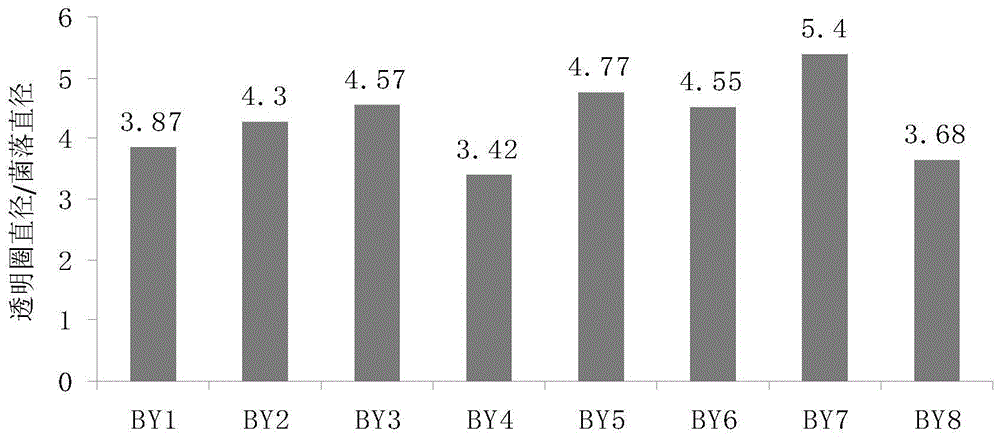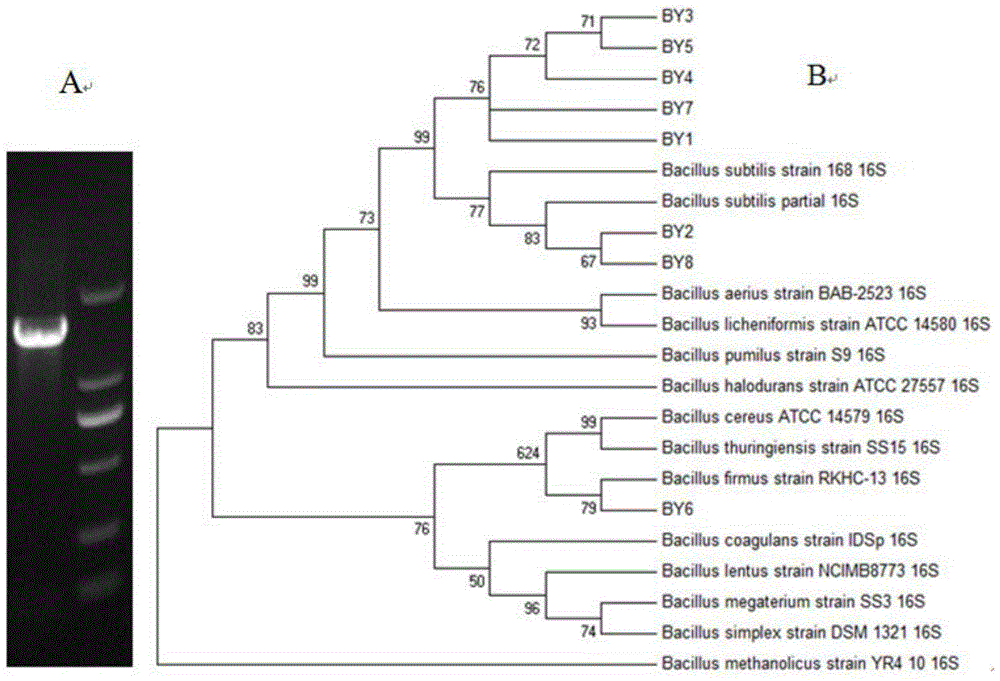Bacillus subtilis BY7 and application thereof in degrading residual feeds and ammonia nitrogen
A Bacillus subtilis and ammonia nitrogen technology, applied in the field of microorganisms, can solve the problems of high ammonia nitrogen content in water, affecting the growth of cultured aquatic animals, endangering the lives of cultured animals, etc., and achieves the effect of reducing ammonia nitrogen content, improving ammonia nitrogen pollution and high safety.
- Summary
- Abstract
- Description
- Claims
- Application Information
AI Technical Summary
Problems solved by technology
Method used
Image
Examples
example 1
[0034] Example 1 Isolation, purification and identification of Bacillus subtilis BY7
[0035] 1. Separation and purification of bacteria
[0036] 1. Enrichment of protein and ammonia nitrogen strains
[0037] Take 100mL of water samples from the tilapia culture pond, freshwater white pomfret culture pond, black snakehead culture pond, carp culture pond, and golden crucian carp culture pond in the hot spring aquaculture experiment field in Daiyue District, and mix the water samples from each culture pond Take 5mL and inoculate it into 100mL enriched medium (add NH to basal medium 4 Cl, adjust the concentration of ammonia nitrogen to 50mg / L to obtain the enrichment medium) in the Erlenmeyer flask, 37 ° C, 200r / min shaking culture for 1 day; take 1 mL of the culture solution after 1 day of cultivation and re-inoculate in 100mL enrichment medium , so repeated enrichment culture for 6 generations.
[0038] 2. Screening and isolation of protein and ammonia nitrogen strains
[00...
example 2
[0062] The research of example 2 Bacillus subtilis BY7 growth conditions
[0063] 1. The effect of C / N on the growth of strains
[0064] 1. Pick a single clone of Bacillus subtilis BY7, inoculate it in 10mL basal medium, and culture it with shaking at 37°C and 200r / min for 12h (make the OD of the bacterial solution in the culture system 600 value reaches 1.0), centrifuged at 4000rpm for 10min, collected the bacteria, and washed 3 times with sterile saline.
[0065] 2. Resuspend the above-mentioned bacteria with sterile normal saline, inoculate 2 mL of the bacterial suspension into 9 conical flasks containing 100 mL of colorless medium (pH 6.0), adjust each conical flask to culture Concentrations of sodium citrate and ammonium chloride in the base, so that the C / N in the 9 Erlenmeyer flask mediums were 1, 3, 4, 5, 6, 7, 9 and 11, and then 37 ° C, 200r / min Shaking culture, sampling once every 2h to determine the OD of the bacterial solution 600 Value, find after cultivating 1...
example 3
[0073] Example 3 Bacillus subtilis BY7 protease activity analysis
[0074] 1. Drawing of standard curve
[0075] 1. Prepare various concentrations of tyrosine solutions according to Table 3
[0076] Table 3 prepares various concentrations of tyrosine solutions
[0077] pipe number
1
2
3
4
5
6
Distilled water (mL)
10
8
6
4
2
0
100μg / mL Tyrosine (mL)
0
2
4
6
8
10
Tyrosine final concentration (μg / mL)
0
20
40
60
80
100
[0078] 2. Take 6 test tubes, labeled No. 1-6, add 0-10 mL of tyrosine at a concentration of 100 μg / mL respectively to prepare a solution with a final concentration of tyrosine as described in Table 3, and then add 0.4 mol / mL of tyrosine to each test tube. L of sodium carbonate solution 5mL and Folin's reagent 1mL. After fully mixing with a mixer, put it in a constant temperature water bath at 37°C to react for 20 minutes.
[0079] 3. Take No. 1 tube as ...
PUM
 Login to View More
Login to View More Abstract
Description
Claims
Application Information
 Login to View More
Login to View More - R&D
- Intellectual Property
- Life Sciences
- Materials
- Tech Scout
- Unparalleled Data Quality
- Higher Quality Content
- 60% Fewer Hallucinations
Browse by: Latest US Patents, China's latest patents, Technical Efficacy Thesaurus, Application Domain, Technology Topic, Popular Technical Reports.
© 2025 PatSnap. All rights reserved.Legal|Privacy policy|Modern Slavery Act Transparency Statement|Sitemap|About US| Contact US: help@patsnap.com



